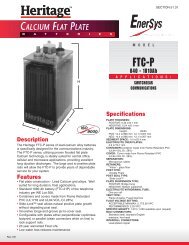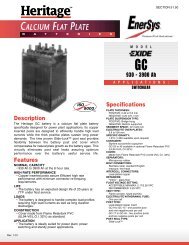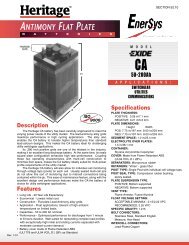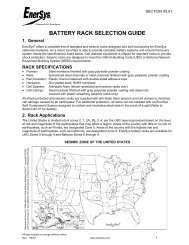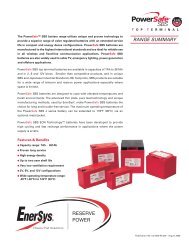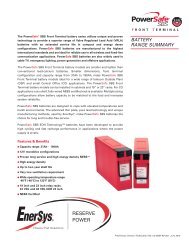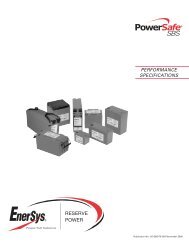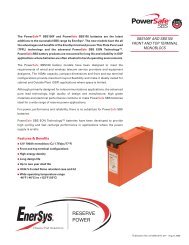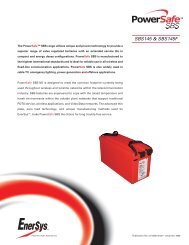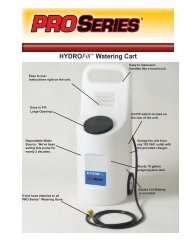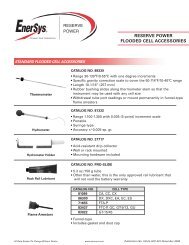PowerSafe V Product Guide new - EnerSys
PowerSafe V Product Guide new - EnerSys
PowerSafe V Product Guide new - EnerSys
Create successful ePaper yourself
Turn your PDF publications into a flip-book with our unique Google optimized e-Paper software.
Battery Sizing<br />
Battery capacity is affected by the discharge rate, end<br />
voltage, temperature and age.<br />
Battery sizing calculations should include factors for<br />
temperature and loss of capacity over life. A battery usually<br />
is determined to have reached end of life when its capacity<br />
has fallen to 80% of its rated capacity.<br />
Strings of the same SBS batteries can be connected in<br />
parallel to obtain higher capacities.<br />
Telecom Applications<br />
In general, telecom applications are a constant power or<br />
constant current load for a specified period, to a specified<br />
end voltage. The appropriate battery model can be selected<br />
by referring to the Discharge Tables.<br />
EXAMPLE 1<br />
The following information is needed:<br />
■ Nominal system voltage<br />
■ Minimum system voltage<br />
■ Load (constant current or constant power)<br />
■ Backup time<br />
■ Temperature range<br />
A nominal 48V system requires a constant current of 9 Amps<br />
for 4 hours to a minimum of 42V at a minimum operating<br />
temperature of 20°C/68°F.<br />
Step 1. Number of cells = nominal system voltage divided<br />
by nominal cell voltage:<br />
48V/ 2V = 24 cells<br />
Step 2. Cell end voltage = minimum system voltage divided<br />
by the number of cells:<br />
42V/ 24 cells = 1.75 volts per cell<br />
Step 3. Correct load for temperature and ageing:<br />
Temperature factor = 1/Factor from Temperature<br />
Correction Chart = 1/0.978 = 1.022<br />
Ageing factor = 100/80 = 1.25<br />
9 amps x temperature factor x ageing factor =<br />
9 amps x 1.022 x 1.25 = 11.5 Amps<br />
www.enersysinc.com<br />
Step 4. Refer to the constant current discharge table for an<br />
end voltage of 1.75 Vpc, and in the 4 hour column<br />
find the model that will provide the load current.<br />
In this example an SBS60 will provide 11.7 amps/<br />
4 Hrs/1.75Vpc SBS60 is a 12V six cell monobloc,<br />
so 4 blocs are required for a 48V battery.<br />
UPS Applications<br />
In general, UPS systems are rated in kVA, (kilo Volt<br />
Amperes). This is a multiplication of the output voltage in<br />
Kilo Volts and output current in amperes. The kVA rating is<br />
always an AC rating. The kVA rating may be converted to kW<br />
by simply multiplying the kVA by the Power Factor (PF).<br />
kW Rating of UPS = (kVA of UPS) x (PF of UPS)<br />
kW Rating of UPS Battery = kVA x PF<br />
Inverter Efficiency<br />
EXAMPLE 2<br />
This first example covers a basic sizing procedure with no<br />
power factor or efficiency involvement. This procedure<br />
details only the fundamental steps required.<br />
In an example such as this the following information is<br />
needed as a minimum requirement:<br />
(i) system kilowatts<br />
(ii) required autonomy (run time)<br />
(iii) minimum DC voltage<br />
(iv) maximum DC voltage<br />
If the load is given in kVA, then the PF and inverter efficiency<br />
values must also be known.<br />
Therefore, for a UPS requiring the following autonomy,<br />
Battery kW Rating: 10<br />
Battery nominal voltage: 120<br />
Battery end voltage: 1.67 Vpc<br />
Battery run time: 10 minutes<br />
Publication No: EN-SBS-PG-001 February 2003<br />
7




